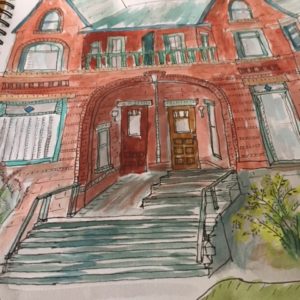From Canada: Cut Flowers and Community
 As mentioned in my last post, we are in Canada for a week. Toronto. We are staying in the Annex neighborhood near the University of Toronto where we lived in 2008 – 09 when I taught at Emmanuel College, a seminary of the United Church of Canada. The sketch here is a fairly typical home (for two families) in the Annex.
As mentioned in my last post, we are in Canada for a week. Toronto. We are staying in the Annex neighborhood near the University of Toronto where we lived in 2008 – 09 when I taught at Emmanuel College, a seminary of the United Church of Canada. The sketch here is a fairly typical home (for two families) in the Annex.
While there are parts of Toronto that are dominated by freeways, cars and malls (big and little ones), this part of Toronto is not. It is quite human in scale, with lots of pedestrians, older homes and small businesses run by people who look older than God.
The neighborhoods have ethnic roots. We are in Toronto’s “Little Italy.” Further west it is “Little Portugal.” Slightly north is “Korea Town.” A much larger “Chinatown” is not far away.
We are close as well to the “Kensington Market,” which combines open-air fresh fruit and vegetable stands, with cheese shops, bakeries, fish stores, butcher shops, speciality clothing haunts, eaterys of every sort and price range, and slightly eccentric touches liked a parked car (on the street) that serves as a planter.
There is something about these neighborhoods that is best described, to my mind, as “organic.” They are living organisms, something more than the sum of their parts. It’s hard to see how it works, but it does.
This is the area of Toronto once inhabited by famous urbanist, Jane Jacobs (The Life and Death of American Cities). Jacobs departed New York City when Robert Moses was presiding there over the hay-day of “slum clearance” and urban planning.
Jacobs came to Toronto, where she successfully led the opposition to a freeway that would have sliced through this Annex neighborhood to reach the downtown core.
The area retains the qualities that Jacobs thought characterized a vibrant urban area. Chief among those is a certain messiness. In a healthy interesting city, in Jane Jacobs view, you don’t have all of one thing in a one place and all of another in a different place (that was the Robert Moses plan — business, industry, residential all widely segregated and separated).
In Jane Jacobs perfect city things are mixed and imperfect, bumping up against one another. Classic architectural gems next door to curious little shops. Theaters proximate to the fire station with a 100′ tower to make Pisa envious.
We love to walk here in Toronto, at least in this part. It is endlessly colorful and entertaining. Being flat helps.
Ordinary life has a richness born of relationships and lots of little human interactions. I recounted, in my previous blog, one such interaction that took place the other day when I was out sketching.
The next day I was sketching in a different place (see above). A guy, some variety of Middle Eastern, pulled up on the quiet street near where I was working. He got out of his car and stood by it eating a home-made lunch, a tortilla wrapped around rice and beans. He watched me sketch.
Turned out he was an Uber driver, having his lunch. “Really,” he said, “I’m an interior designer, but right now Uber.” He offered to share his lunch with me. True story. I accepted a handful of almonds from a plastic bag he held out. “Take more.” “Thanks, I’m good.”
Of course, Toronto has its seamy side too. It wasn’t long ago that a driver plowed into pedestrians over on Yonge Street, where tomorrow’s Gay Pride Parade will be.
But still, in this area of Toronto, things are on a human scale, with lots of interactions which one can both observe and participate in.
The organic quality of these neighborhoods, of this city, is something that takes time. In Seattle there’s interest in urban villages and something called “the new urbanism.” I’m thinking of today’s Ballard, or of the housing that has sprung up around various light rail stops. Nice, but it resembles a cut flower. No roots. No history.
Linda told me years ago about a school administrator new to Seattle who was having a party at her home. She wanted flowers blooming around her house for the party. She didn’t understand that you have tulips or daffodils because you planted them the previous fall. So she went to a store, bought cut flowers and put them in the ground.
Sometimes the ventures of Seattle’s new urbanism seem a bit like that — cut flowers.
Organic neighborhoods and cities take time. They honor the past. They are more relational than rational. They don’t scrape off everything that has gone before and stick cut flowers in the ground. It’s more mysterious than that. Organic communities take time, relationships and a thousand daily interactions that build something intangible but palpable.
![Anthony B. Robinson [logo]](https://www.anthonybrobinson.com/wp-content/themes/anthonybrobinson/images/logo.png)
![Anthony B. Robinson [logo]](https://www.anthonybrobinson.com/wp-content/themes/anthonybrobinson/images/logo-print.png)